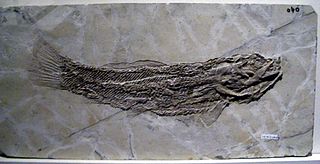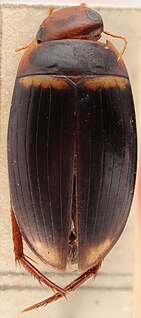
The Amiiformes order of fish has only one extant species, the bowfin. These Amiiformes are found in the freshwater systems of North America, in the United States and parts of southern Canada. They live in freshwater streams, rivers, and swamps.

The Elopiformes are the order of ray-finned fish including the tarpons, tenpounders, and ladyfish, as well as a number of extinct types. They have a long fossil record, easily distinguished from other fishes by the presence of an additional set of bones in the throat.

The anis are the three species of birds in the genus Crotophaga of the cuckoo family. They are essentially tropical New World birds, although the range of two species just reaches the United States.

The Veneridae or venerideees, common name: venus clams, are a very large family of minute to large, saltwater clams, marine bivalve molluscs. Over 500 living species of venerid bivalves are known, most of which are edible, and many of which are exploited as food sources.

Copelatus is a large genus of small diving beetles. There are some 470 described species in the genus, found worldwide, but they are most diverse in tropical South America, Africa and South-East Asia.

Hydraenidae is a family of very small aquatic beetles, sometimes called "minute moss beetles", with a worldwide distribution. These beetles are generally 1–3 mm in length with clubbed antennae. They do not swim well and are generally found crawling in marginal vegetation. Most are phytophagous but a few saprophagous and predatory species are known.

Wasmannia is a genus of ants. Wasmannia auropunctata is known as the electric ant or little fire ant and are considered by many countries to be a destructive, highly invasive species.
Copelatus biseriatus is a species of diving beetle. It is part of the genus Copelatus in the subfamily Copelatinae of the family Dytiscidae. It was described by J. Balfour-Browne in 1939.
Copelatus concolorans is a species of diving beetle. It is part of the genus Copelatus of the subfamily Copelatinae in the family Dytiscidae. It was described by J. Balfour-Browne in 1939.
Copelatus fontanus is a species of diving beetle. It is part of the genus Copelatus in the subfamily Copelatinae of the family Dytiscidae. It was described by J. Balfour-Browne in 1950.
Copelatus fulviceps is a species of diving beetle. It is part of the genus Copelatus in the subfamily Copelatinae of the family Dytiscidae. It was described by J. Balfour-Browne in 1938.
Copelatus hardenbergi is a species of diving beetle. It is part of the genus Copelatus in the subfamily Copelatinae of the family Dytiscidae. It was described by J. Balfour-Browne in 1950.
Copelatus latus is a species of diving beetle. It is part of the genus Copelatus in the subfamily Copelatinae of the family Dytiscidae. It was described by J. Balfour-Browne in 1950.
Copelatus tostus is a species of diving beetle. It is part of the genus Copelatus in the subfamily Copelatinae of the family Dytiscidae. It was described by J.Balfour-Browne in 1950.
Merogregarina is a genus of parasitic alveolate in the phylum Apicomplexa. Species in this genus infect marine invertebrates.

Botrynema ellinorae is a species of hydrozoan in the family Halicreatidae.

Botrynema brucei is a common mid-water Arctic hydrozoan, of the family Halicreatidae.

Epimetopidae is a family of semi-aquatic beetles found on the edges of streams and shallow freshwater ponds. These beetles are shorter than half a centimeter long and have a pronotum with a central projection forming a shelf above the head. On the underside of the abdomen only four sternites are visible. There are less than a hundred species in three genera, Epimetopus which is restricted to the New World, mostly Neotropical, Eupotemus with two Afrotropical species and Eumetopus with some Oriental species. Females carry their eggcases on the underside of the abdomen.
Lovenella is a genus of cnidarians belonging to the family Lovenellidae.











